AP State Syllabus AP Board 6th Class Science Solutions Chapter 12 Movement and Locomotion Textbook Questions and Answers.
AP State Syllabus 6th Class Science Solutions 12th Lesson Movement and Locomotion
6th Class Science 12th Lesson Movement and Locomotion Textbook Questions and Answers
Improve Your Learning
Fill in the Blanks.
1. Joints of the bone helps in the ——–.
Answer:
movements.
2. The contraction of the ——– pulls the bones during movement.
Answer:
muscle.
3. The bones at the elbow are joined by a ——– joint.
Answer:
hinge.
![]()
Choose the correct answer.
1. The immovable joints are present in
A) Knee
B) Shoulder
C) Neck
D) Skull
Answer:
2. The hollow bones are present in
A) Cow
B) Sparrow
C) Buffalo
D) Snake
Answer:
3. The fibers join the muscles to the bones.
A) Tendon
B) Ligament
C) Cartilage
D) None
Answer:
A) Tendon
The joint response to move our head up and down and side to side is
A) Sliding joint
B) Hinge joint
C) Ball and socket joint
D) Pivot joint
Answer:
D) Pivot joint
![]()
Answer the Following Questions.
Question 1.
Write short notes on different types of joints in our body.
Answer:
1. The point where two bones meet is called a joint.
2. Joints are of two types. They are movable and immovable (fixed).
3. Movable joints are four types namely 1. Ball and socket 2. Hinge 3. Sliding 4. Pivot
joints.
- Ball and socket: The rounded end of one bone fits into the hollow end of the other bone. Such a joint allows movement in all directions. This joint is known as the ball and socket joint. It is present at the shoulder and at the hip region.
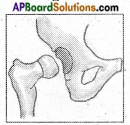
- Hinge joint: Like the hinge of a door, the joint which helps the bones to move in one direction is called a hinge joint. These are present at the elbow and knee.
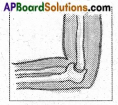
- Sliding joint: The joint where the bones slide over each other is called the sliding joint. It is present in the vertebral column, wrist, and ankle.
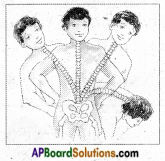
- Pivot joint: The joint that joins the skull to the backbone is called the pivot or neck joint, pivot or neck joint.

Question 2.
What are the uses of muscles and bones?
Answer:
- Muscles helps in the locomotion and movements of the body, they also provide shape and structure to the body.
- Bones provide a base to muscles. They have a key role in body movements and the shape of the body.
![]()
Question 3.
Differentiate the ball and socket joint from the hinge joint.
Answer:

Question 4.
How is the body of a fish suitable for swimming?
Answer:
- The skeleton of the fish is covered with strong muscles.
- While swimming,-muscles make the front part of the body swing towards one side while the tail swings its body towards the opposite.
- This creates a jerk and pushes the body forward.
- A series of such jerks help the fish swim forward.
- The tail fins also aid in this movement.
Question 5.
Guess who I am?
i) I am a joint that works like a joint of doors and windows.
Answer:
Hinge joint.
ii) I help to join two bones.
Answer:
Ligament.
iii) I am a joint between the upper jaw and skull.
Answer:
Fixed joint.
iv) I am a chain of small-small bones.
Answer:
Vertebral column or backbone.
v) I join the bone and muscle.
Answer:
Tendon.
![]()
Question 6.
What would happen if there are no bones and joints in our body?
Answer:
If there are no bones and joints in our body
- we do not have a particular body shape,
- movements and locomotions are not possible.
- Simply we become round as mass body.
Question 7.
What would happen if there is a single bone in your fingers?
Answer:
If we have a single bone in our fingers.
- we can’t fold the fingers.
- we can’t catch or hold anything.
- it becomes hard to get food.
- we cant manage any apparatus.
- in the evaluation, we become so backward.
Question 8.
Draw a neat and labeled diagram of the Ball and socket joint and write its location and uses.
Answer:

These joints are located in the shoulders and hip region. It is used in swinging and rotating movements.
Question 9.
How do you appreciate locomotion in birds?
Answer:
I feel wonder about flying of birds.
They have wonderful wings and attractive feathers. Birds are only creatures that fly easy to escape.
This feature also help them in long journey to migrate. I feel its beautiful if I have wings to fly.
Activities and Projects
6th Class Science Textbook Page No. 139
Question 1.
Collect information regarding joint pains from an orthopedic.
Answer:
Joint pain can be discomfort, pain or inflammation arising from any part of a joint — including cartilage, bone, ligaments, tendons or muscles. Most commonly, however, joint pain refers to arthritis or arthralgia, which is inflammation or pain from within the joint itself.
- Inflammatory foods. “Arthritis” is a general term encompassing conditions that share joint pain and inflammation ….
- Fried and processed foods …
- Lower your Ages ….
- Sugars and refined carbs ….
- Dairy products ….
- Alcohol and tobacco ….
- Salt and preservatives ….
- Corn oil
- Non-steroidal anti-inflammatory drugs called NSAIDs help relieve joint swelling, stiffness, arid pain — and are among the most commonly used pain killers for people with any type of arthritis.
Natural relief from Arthritis pain
- Weight.
- Exercise.
- Heat and cold.
- Acupuncture.
- Meditation.
- Fatty acids.
- Turmeric.
- Massage.
![]()
Question 2.
List out the activities that you performed at your home and which joints were involved in each activity.
Answer:
We cannot perform any movement without the involvement of joints. They have key role in our daily activities.
ACTIVITIES INVOLVED JOINTS
1. Walking Hinge and gliding joints
2. Running Hinge and gliding joints
3. Bowling Ball and socket joint
4. Playing Ball and socket, hinge, gliding, and pivot joints
5. Dancing Ball and socket, hinge, gliding, and pivot joints
6. Painting Gliding joint
7. Driving Hinge, gliding joints
Question 3.
Observe the whole body of a hen from the internet and make a list of different joints, bones, muscles, tendons and ligaments present in it.
Answer:
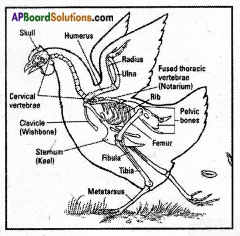
Question 4.
Try to identify the joints in the body of a goat through the internet and make a list of those joints.
Answer:

![]()
Question 5.
Collect X-ray films and identify which body part they represent and write a note on them.
Answer:
- Gliding joint: A gliding joint is a joint which allows only gliding movement.
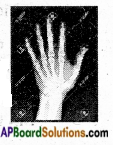
The gliding joint allows one bone to slide over the other. The gliding joint in your wrist allows you to flex your wrist. It also allows you to make very small side-to-side motions. There are also gliding joints in your ankles and backbone. - Pivot joint: Only allows rotating movement. The joint that joins the skull to the backbone is called the pivot or neck joint.
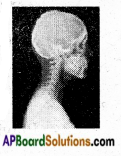
- Ball-and-socket joint: The ball-shaped surface of one bone fits into the cup-like shape of another. Examples of a ball-and-socket joint include the hip and the shoulder.

- Hinge joint: The ends of the bones are shaped in a way that allows motion in two directions, forward and backward. Examples of hinge joints are the knees and elbows.
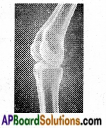
- Rib cage: Ribs are bent which joins the chest bone and the backbone together to form a box. This is called the rib cage.

6th Class Science 12th Lesson Movement and Locomotion Activities
Activity – 1
1. Human body and its movement (Page No. 128)
Do the following actions:
- Bowl an imaginary ball at an imaginary wicket.
- Lie down and try to rotate your leg at the hip.
- Bend your arm at the elbow and your leg at the knee.
- Stretch your arms sideways, chew some food, bend your arm to touch your shoulder with your finger and try to move other body parts as well.
![]()
Record your observations in table
Table
| S.No. | Body Part | Rotates Partially/Completely | Bends (Yes/No) | Lifts (Yes/No) | Moves (Yes/No) |
| 1. | Neck | ||||
| 2. | Wrist | ||||
| 3. | Finger | ||||
| 4. | Knee | ||||
| 5. | Ankle | ||||
| 6. | Toes | ||||
| 7. | Back | ||||
| 8. | Head | ||||
| 9. | Elbow | ||||
| 10. | Arm | ||||
| 11. | Upper Jaw |
Answer:
| S.No. | Body Part | Rotates Partially/Completely | Bends (Yes/No) | Lifts (Yes/No) | Moves (Yes/No)’ |
| 1. | Neck | Partially | Yes | Yes | Yes |
| 2. | Wrist | r Partially | Yes | Yes | Yes |
| 3. | Finger | Partially | Yes | Yes | Yes |
| 4. | Knee | Partially | Yes | Yes | Yes |
| 5. | Ankle | Partially | Yes | Yes | Yes |
| 6. | Toes | Partially | Yes | Yes | Yes |
| 7. | Back | Partially | Yes | Yes | Yes |
| 8. | Head | Partially | Yes | Yes | Yes |
| 9. | Elbow | Partially | Yes | Yes | Yes |
| 10. | Arm | Partially | Yes | Yes | Yes |
| 11. | Upper Jaw | No | No | No | No |
![]()
Activity – 2
2. Let us see how animals move from one place to another. Fill in your observations in the table. (Page No. 136)
| Animal | Body parts used for moving | How does the animal move |
| Cow | Legs | |
| Human | Walks, Jumps,….. | |
| Snake | ||
| Bird | Hope flies…… | |
| Insect | ||
| Fish |
Answer:
| Animal | Body parts used for moving | How does the animal move |
| Cow | Legs | Walks, runs |
| Human | Legs | Walks, Jumps,….. |
| Snake | Scales | Crawls |
| Bird | Legs, Wings | Hope flies…… |
| Insect | Legs, wings | Walk, jump, fly |
| Fish | Fins | Swimming |